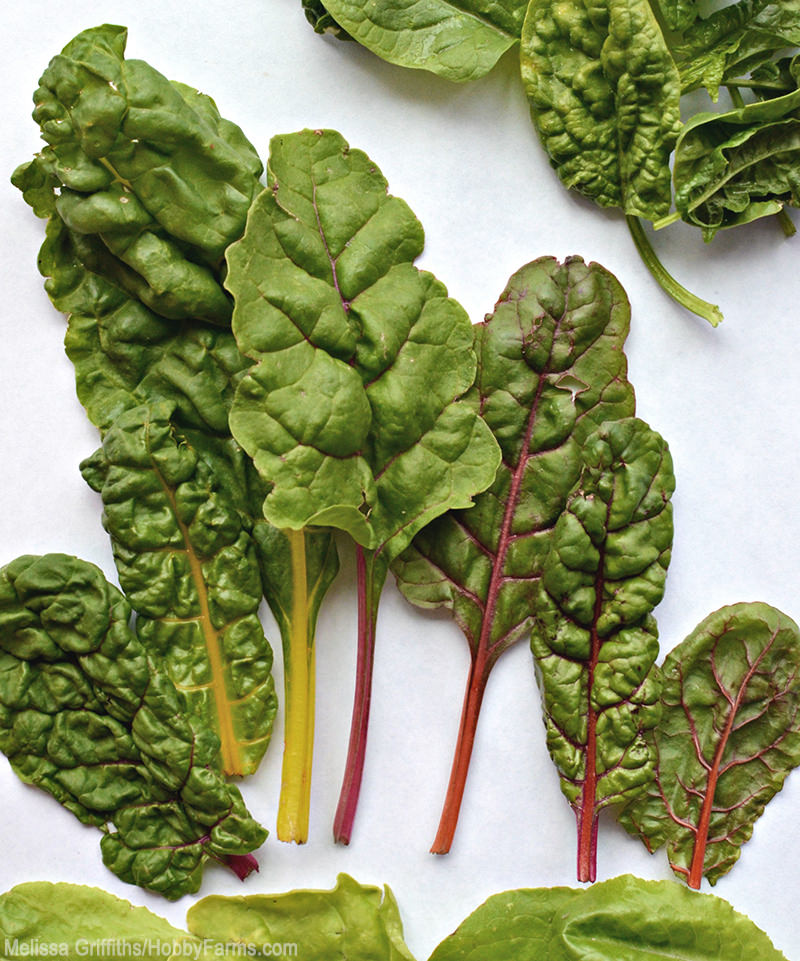

Swiss chard has been around for a very long time, but if it’s new to you, there’s no better time to get acquainted with this beautiful, delicious leafy green. Swiss chard was used by the ancient Greeks for food and medicine and is still a well-loved vegetable in the Mediterranean. You can find it in most grocery stores, though like most vegetables, it’s superior when grown at home.
Growing and Harvesting Chard
Swiss chard comes in two general varieties: The more traditional Swiss chard has a white stem and large, ruffled, dark-green leaves; colored chard, aka rainbow chard, has similar leaves and red, pink, orange and yellow stalks. Both varieties are easy to grow and do well in most climates, as long as they’re protected from heavy frost. Sow seeds in early spring, water well, and harvest when the leaves and stalks are young and tender. Like most greens, chard doesn’t fare well in the extreme heat of mid-summer, but keep watering: When things start to cool off in the fall, you’ll likely get a second harvest.
Swiss chard is best picked small, and often the grocery store only carries very large, almost stalk-like pieces. You can remove the stalks before using and feed them to your hens or compost them, or you can treat the stalks like celery and add them to soups and stews. Growing your own ensures you can pick it when the leaves are 4 to 6 inches long (or even smaller for fresh salads) and the stems very thin and tender. You’ll also likely find fresher, tenderer chard at your local farmers’ market.
Don’t wash your chard before storing it, as the water will promote spoiling. Store your chard in a sealed plastic bag in your produce drawer, and wash as you use it. It should last two to four days in the fridge, depending on when it was picked.

While Swiss chard is a great green for salads or a light sauté, here are a few simple ways to use it that may not have crossed your mind.
1. Green Smoothies
Replace your typical spinach in green smoothies with Swiss chard. Here’s a simple recipe to try: Add one frozen banana, 1 cup frozen berries of your choice, a handful of Swiss chard, 1/2 cup vanilla yogurt, and 2 cups milk in a blender and process until smooth. Drink right away. You’ll never even know the greens are in there, but you’ll be getting all their health benefits. Swiss chard can also be juiced, though you’ll lose out on the fiber content.
2. Pasta Sauce
Try mixing Swiss chard into your favorite pasta sauce. Chop a handful of chard well and add it when you’re sautéing your onion. Your family will never know because it looks like you used extra basil in your sauce.
3. Soup
Swiss chard is excellent in soups. Roughly chop it and add it to your favorite soup about 5 minutes before the end of the cooking time. Allow the chard to wilt before serving. This is a great addition to tortellini, minestrone, beef vegetable and other vegetable-heavy soups.
4. Egg Dishes
Making a savory quiche, strata or frittata? Mix in a handful of chopped Swiss chard before baking and enjoy a little extra color and flavor in your dish.
5. Pickled Chard Stalks
Chard is best used fresh, but you can pickle larger stems. Use your favorite refrigerator pickle or pickled beets recipe, and either replace the other vegetables with the stems or add the stems to what you’re already pickling.
6. Freeze It
If you have a bumper crop of chard, it can be frozen: To freeze chard you’ll need to wash it, chop it, and then blanch it for 2 minutes, working in small batches. After the chard is blanched, shock it in an ice-water bath and then remove it with a slotted spoon. Place it on paper towels or give it a spin in a salad spinner to remove extra moisture. Portion the blanched chard into freezer bags (1 cup is a good amount per bag), add the date, and freeze. Frozen chard should be used within 6 months. Add it to cooked dishes, like soups, stews, pasta sauces or quiche. You could also use this in your smoothie recipes (though a whole cup might be too much for one smoothie) since it gets blended up.
Chard is a gorgeous vegetable that’s easy to grow, delicious to eat, and versatile in the kitchen. It even grows nicely in well watered containers if your space is limited. Look for it early in the spring at the farmers’ market and plan on putting in a row of it in your home garden as soon as you can plant in the spring.
Get more recipe ideas from HobbyFarms.com:
- 5 Cool Ways to Use Your Cucumber Harvest
- 3 Ways to Use Your Okra Year-Round
- 7 New Ways to Preserve Squash
- 9 Ways to Preserve Peppers For Winter
- 3 Ways to Preserve Fresh Oranges




